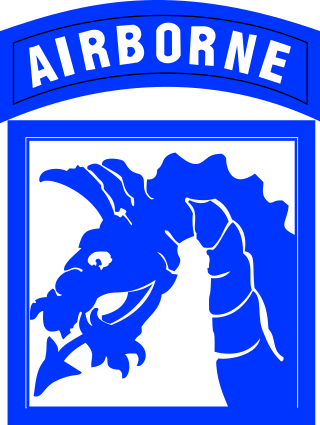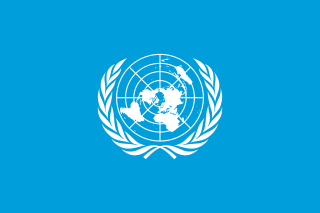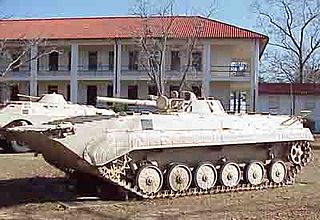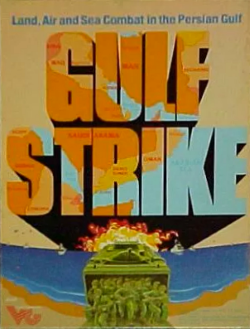
The Iraqi Republican Guard was a branch of the Iraqi military from 1969 to 2003, which existed primarily during the presidency of Saddam Hussein. It later became known as the Republican Guard Corps, and then the Republican Guard Forces Command (RGFC) with its expansion into two corps. The Republican Guard was disbanded in 2003 after the invasion of Iraq by a U.S.-led international coalition.

The Gulf War was an armed conflict between Iraq and a 42-country coalition led by the United States. The coalition's efforts against Iraq were carried out in two key phases: Operation Desert Shield, which marked the military buildup from August 1990 to January 1991; and Operation Desert Storm, which began with the aerial bombing campaign against Iraq on 17 January 1991 and came to a close with the American-led liberation of Kuwait on 28 February 1991.

The Iraqi no-fly zones conflict was a low-level conflict in the two no-fly zones (NFZs) in Iraq that were proclaimed by the United States, United Kingdom, and France after the Gulf War of 1991. The United States stated that the NFZs were intended to protect the ethnic Kurdish minority in northern Iraq and Shiite Muslims in the south. Iraqi aircraft were forbidden from flying inside the zones. The policy was enforced by the United States and the United Kingdom until 2003, when it was rendered obsolete by the 2003 invasion of Iraq. French aircraft patrols also participated until France withdrew in 1996.

The XVIII Airborne Corps is a corps of the United States Army that has been in existence since 1942 and saw extensive service during World War II. The corps is designed for rapid deployment anywhere in the world and is referred to as "America's Contingency Corps." Its headquarters are at Fort Liberty, North Carolina.

Herbert Norman Schwarzkopf Jr. was a United States Army general. While serving as the commander of United States Central Command, he led all coalition forces in the Gulf War against Ba'athist Iraq.

The Battle of 73 Easting was fought on 26 February 1991, during the Gulf War, between Coalition armored forces and Iraqi armored forces. It was named for a UTM north–south coordinate line that was used as a phase line by Coalition forces to measure their progress through the desert. The battle was later described by Lt. John Mecca, a participant, as "the last great tank battle of the 20th century." This battle took place several hours after another, smaller, tank battle at Al Busayyah.

The Battle of Medina Ridge was a tank battle fought on the 27 February 1991, during the Gulf War, between the U.S. 1st Armored Division and the 2nd Brigade of the Iraqi Republican Guard Medina Luminous Division outside Basra, Iraq. The U.S. 3rd Brigade, 3rd Infantry Division, was also a major contributor, by leading the attack. Iraq's Adnan Motorized Division was also a participant. Medina Ridge is the name American troops gave to a low rise, approximately seven miles (11 km) long.

Conflict: Desert Storm is a tactical shooter video game developed by Pivotal Games and published by SCi Games and Gotham Games for Microsoft Windows, PlayStation 2, Xbox, and GameCube; it is the first installment in the Conflict series. Another game of the same name was produced for Mobile phones, developed by Synergenix and published by Kayak Interactive.

Opération Daguet was the codename for French operations during the 1991 Gulf War. 18,000 members of the French Armed Forces were deployed during the conflict and they represented the second largest European contingent. Operating on the left flank of the US XVIII Airborne Corps, the ground component of the French force, named Division Daguet, was formed in September 1990 in Saudi Arabia as part of France's contribution to Operation Desert Shield. France also deployed several combat aircraft and naval units. Opération Daguet was commanded by Army general Michel Roquejeoffre.

On 29 November 1990, the adoption of United Nations Security Council Resolution 678 authorized the assembly of a multinational military coalition to liberate Iraqi-occupied Kuwait by "all necessary means" if Iraq did not withdraw its forces by 15 January 1991. Iraq failed to do so, and the coalition began an aerial bombardment against targets in Iraq and Kuwait on 17 January 1991. At this time, the coalition consisted of 42 countries and was spearheaded by the United States. The central command was led by the United States, Saudi Arabia, and the United Kingdom; the marine command was led by the United States; the Joint Forces East Command was led by Egypt, Saudi Arabia, Syria, Morocco, Kuwait, Oman, the United Arab Emirates, Qatar, Bahrain, Poland, and Czechoslovakia; and the Joint Forces North Command was led by the United States, the United Kingdom, France, Canada, Italy, Australia, and Turkey.
The 64th Armor Regiment is an armor regiment of the United States Army, organized under the United States Army Regimental System. It is descended from the 758th Tank Battalion (Light) that served in the Italian campaign during World War II. Redesignated as the 64th Tank Battalion, it was assigned to the 3rd Infantry Division during the Korean War and it spent most of the Cold War stationed in West Germany before elements were transferred to Ft. Stewart, Georgia in the late 1990s. The regiment participated in Desert Shield, Desert Storm, Desert Fox, Desert Spring, Operation Iraqi Freedom and Operation Enduring Freedom.

The Liberation of Kuwait campaign was led by the United States between 24 and 28 February 1991, consisting of a major ground offensive into Iraqi-occupied Kuwait following the successful Gulf War air campaign. Approximately 650,000 troops of the American-led 42-country coalition swept into Kuwait to find the bulk of the 500,000 Iraqi troops surrendering en masse, but there were still pockets of resistance in some parts of the country. A particularly fierce battle took place at Kuwait International Airport, where Iraqi troops, seemingly unaware that a retreat order had been issued to them, continued to fight against the coalition's advance. By the end of February, Kuwait was declared free of the Iraqi occupation. The coalition then proceeded to push into Iraq, where the majority of the fighting occurred. Shortly thereafter, combat operations ceased and the Gulf War was brought to a close.

The 5th Field Artillery Regiment was constituted as part of the Regular Army in January 1907. Individual battalions have lineages which date back further. Currently, it is a parent regiment under the U.S. Army Regimental System, with a single active battalion, the 1st Battalion, 5th Field Artillery, which is assigned to the 1st Division Artillery, 1st Infantry Division at Fort Riley, Kansas.

The Battle of Rumaila, also known as the Battle of the Causeway or the Battle of the Junkyard, was a controversial attack that took place on March 2, 1991, two days after President Bush declared a ceasefire, near the Rumaila oil field in the Euphrates Valley of southern Iraq, when the U.S. Army forces, mostly the 24th Infantry Division under Major General Barry McCaffrey engaged and nearly annihilated a large column of withdrawing Iraqi Republican Guard armored forces during the immediate aftermath of the Gulf War.
The 3rd Field Artillery Regiment is a field artillery regiment of the United States Army, first formed in 1812, although regimental units trace their lineages as far back as 1794. Based on the service of these antecedents, the regiment claims battle honors for the War of 1812, the Seminole campaign, the Mexican War, the Civil War, the Spanish–American War, and the Philippine Insurrection. The regiment served with the 6th Division during World War I, with the 5th Division, 6th Division and 2d Cavalry Division between the world wars, and with the 9th Armored Division during and after World War II. Since 1961, the regiment has been a parent regiment under the Combat Arms Regimental System and the U.S. Army Regimental System, with regimental elements serving with the 1st, 6th, and 8th Infantry Divisions; 2nd and 3rd Armored Divisions; 1st Cavalry Division; 194th Armored Brigade; and various field artillery brigades and groups. Three regimental battalions are currently active: the 2nd Battalion in the 1st Armored Division and the 1st Battalion and 5th Battalion, both a part of the 17th Field Artillery Brigade.

The Desert Shield and Desert Storm Memorial is under planning to be constructed in Washington, D.C. near the Lincoln Memorial. It will honor members of the armed forces who participated in Operation Desert Storm or Operation Desert Shield.
Desert Storm is a codename for the Gulf War (1990–1991), a war against Iraq by a U.S.-led coalition, following Iraq's invasion of Kuwait.

The Battle of Kuwait International Airport occurred on February 27, 1991, during the 1st Gulf War. It was a tank battle between the United States and Iraq. Despite being a very large battle it is often overlooked compared to the other battles which took place during the war. No less than elements of 18 divisions total participated in this battle. US Army Special Forces units and multiple Iraqi Commando units were also in theatre. In reality the battle took place over a span of three days despite the primary battle at Kuwait International Airport lasting only one day. Much of the combat actually took place en route to the airport. The battle featured the "Reveille Engagement" which went on to become the biggest and fastest tank battle in United States Marine Corps' entire history.
The timeline of the Gulf War details the dates of the major events of the 1990–1991 war. It began with the Iraqi invasion of Kuwait on 2 August 1990 and ended with the Liberation of Kuwait by Coalition forces. Iraq subsequently agreed to the United Nations' demands on 28 February 1991. The ground war officially concluded with the signing of the armistice on 11 April 1991. However, the official end to Operation Desert Storm did not occur until sometime between 1996 - 1998. Major events in the aftermath include anti-Saddam Hussein uprisings in Iraq, massacres against the Kurds by the regime, Iraq formally recognizing the sovereignty of Kuwait in 1994, and eventually ending its cooperation with the United Nations Special Commission in 1998.

Gulf Strike, subtitled "Land, Air and Sea Combat in the Persian Gulf", is a board wargame published by Victory Games in 1983. The first and second editions were hypothetical games focussed on American responses to Iranian aggression in the Persian Gulf. The third edition, published in 1990, was updated to reflect the reality of Operation Desert Shield during the Gulf War.















